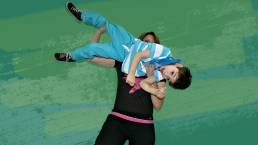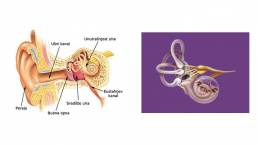MEDEK CUEVAS
The CME method is based on the stimulation of the balance system
1. CME CAUSES THE APPEARANCE OF MOTOR FUNCTIONS - which were absent during psychomotor development.
The usual approach of traditional rehabilitation methods is to give children much more assistance during exercise than necessary, and to repeat motor functions that they already control.
A classic example is a one-year-old child who cannot stand on his own, and the only way to stay in this position is to hold on to an object with two hands. A traditional rehabilitation plan for working with this toddler would be the use of walkers, walking in parallel bars and the like, so that the child could maintain this position with the support of his arms.

According to the first characteristic of CME method, the main goal would be to PROVOKE standing WITHOUT support.
How is this achieved?
It is achieved thanks to the following feature of CME, which is…
2. DISTALIZATION:
Distalization means that the child’s grip is as low as possible in order to INDEPENDENTLY maintain a given position.
If we continue with the above example, a child who can maintain a standing position without any difficulty by holding each bar in the hip area, the next step of CME method would be lowering the bars to the thigh area. As the child masters this position on his own for longer and longer, the next step would be holding the bars at knee height – and this is actually the third feature of this method, which is…
3. CHALLENGE FOR THE BRAIN
This is exactly the core of the method that Mr. Medek Cuevas set as one of the most important postulates in the treatment of children with motor challenges!
Medek designed 100 exercises that he shared with us as Levels I and II.
They are divided into three main groups:
- The first involves the stimulation of head posture.
- The second involves the stimulation of the head and trunk.
- The third group of exercises includes stimulation of standing and walking
EVERY exercise causes the brain to react to the body, so that it independently maintains either the head or the trunk or an upright position WITHOUT the help of a therapist!
Exactly how the brain is “triggered” to action can be explained through the following three postulates of the CME method:
The head and body are brought to a SPECIAL POSITION (a special angle). It is only at that angle that the BALANCE SYSTEM is STIMULATED and provokes an automatic reaction of the brain, i.e. AUTOMATION OF MOVEMENTS IS CAUSED.
4. STIMULATION OF THE BALANCE SYSTEM
The balance system (i.e. the vestibular system) is located in the inner ear.
If you place your palm slightly above and behind the auricle in that area, this is the location of the most important organ which allows us to balance and coordinate movements every day, i.e. to lie down, sit, stand and walk without the difficulties and challenges that children with motor and psychomotor development disorders have to face every day.
The balance system consists of a complex system of bone cavities that at first glance resembles a snail:
- utriculus and sacculus
- and three semicircular canals-anterior, posterior and horizontal
The utriculus and sacculus send information to the brain about rectilinear head movement, acceleration, and the ever-present gravitational force.
The semicircular canals are placed at an angle of 90 degrees to each other and are responsible for information about the rotational movement of the head in all three planes.

Each of the exercises is specifically aimed at stimulating at least one of these channels, which directly affects the stimulation of balance (as well as the development of connections between this system and the connections of the cerebellum and vision).
So far, I have studied a large number of methods such as the TheraSuit method, the Anat Baniel method, I have applied Vojta, ABR and Bobath methods on my son, but NOT ONE METHOD was specifically aimed at stimulating the balance system!
5. SPECIAL ANGLE
Each exercise is designed so that the head and body are always brought to a SPECIAL POSITION (angle) which will cause their AUTOMATIC movement, opposite to the force of gravity and bring them to an upright position.
6. AUTOMATION OF MOVEMENTS
When we walk, we don’t think about whether we are taking a step with our left or right foot. Which leg is in support and which is in the swing phase. Traditional rehabilitation just teaches the impaired brain how to perform this motor action in this way.
Toddlers who have slow psychomotor development also have slowed thinking. While the brain processes the information it is given – the speed of the step, which is measured in milliseconds, slows down to the level of ten or more seconds.
When the balance is already impaired, it is impossible for the child to take a step on his own, because by the time he makes a diagram in his head of how he should lift his leg from the hip to extend it and lean on it, he has already lost his balance.
Imagine what it’s like for a toddler, if he has to think about each step individually. Don’t you agree that while walking, the child would have to activate the thought process intensively, which would soon become extremely tiring for him, both mentally and physically!
Therefore, there are no commands like “raise your head”, “stand up”, “take a step”. These exercises teach the brain to PERFORM these actions AUTOMATICALLY, which is certainly faster and more purposeful!!!
7. GRADUAL EXPOSURE OF BODY SEGMENTS TO GRAVITATIONAL FORCE
Gravitational force is the main external factor that stimulates the body’s neuro-musculoskeletal response. When the child is gradually exposed to this force, the sensory receptors are stimulated to cause an adequate postural response.
This is achieved by gradually introducing more and more demanding exercises when the child gradually takes control of the newly learned posture and movement.
8. STRETCHING AND STRENGTHENING OF MUSCLES IS INTEGRATED INTO THE EXERCISE PROCESS ITSELF
Any passive muscle stretching is excluded in the Medek exercise system. The muscles are stretched and strengthened, but DYNAMICALLY – ACTIVELY.